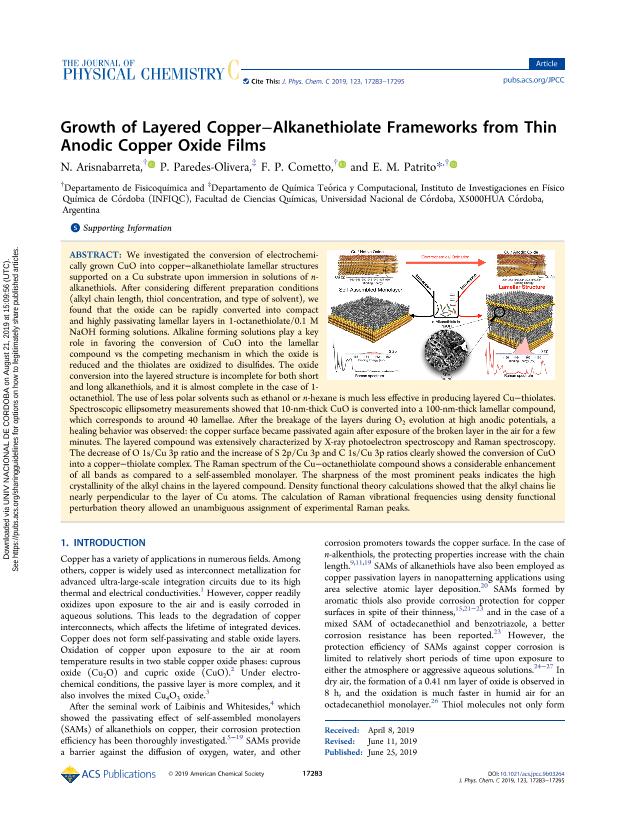Artículo
Growth of Layered Copper-Alkanethiolate Frameworks from Thin Anodic Copper Oxide Films
Arisnabarreta, Nicolás ; Paredes Olivera, Patricia
; Paredes Olivera, Patricia ; Cometto, Fernando Pablo
; Cometto, Fernando Pablo ; Patrito, Eduardo Martin
; Patrito, Eduardo Martin
 ; Paredes Olivera, Patricia
; Paredes Olivera, Patricia ; Cometto, Fernando Pablo
; Cometto, Fernando Pablo ; Patrito, Eduardo Martin
; Patrito, Eduardo Martin
Fecha de publicación:
06/2019
Editorial:
American Chemical Society
Revista:
Journal of Physical Chemistry C
ISSN:
1932-7447
Idioma:
Inglés
Tipo de recurso:
Artículo publicado
Clasificación temática:
Resumen
We investigated the conversion of electrochemically grown CuO into copper-alkanethiolate lamellar structures supported on a Cu substrate upon immersion in solutions of n-alkanethiols. After considering different preparation conditions (alkyl chain length, thiol concentration, and type of solvent), we found that the oxide can be rapidly converted into compact and highly passivating lamellar layers in 1-octanethiolate/0.1 M NaOH forming solutions. Alkaline forming solutions play a key role in favoring the conversion of CuO into the lamellar compound vs the competing mechanism in which the oxide is reduced and the thiolates are oxidized to disulfides. The oxide conversion into the layered structure is incomplete for both short and long alkanethiols, and it is almost complete in the case of 1-octanethiol. The use of less polar solvents such as ethanol or n-hexane is much less effective in producing layered Cu-thiolates. Spectroscopic ellipsometry measurements showed that 10-nm-thick CuO is converted into a 100-nm-thick lamellar compound, which corresponds to around 40 lamellae. After the breakage of the layers during O2 evolution at high anodic potentials, a healing behavior was observed: The copper surface became passivated again after exposure of the broken layer in the air for a few minutes. The layered compound was extensively characterized by X-ray photoelectron spectroscopy and Raman spectroscopy. The decrease of O 1s/Cu 3p ratio and the increase of S 2p/Cu 3p and C 1s/Cu 3p ratios clearly showed the conversion of CuO into a copper-thiolate complex. The Raman spectrum of the Cu-octanethiolate compound shows a considerable enhancement of all bands as compared to a self-assembled monolayer. The sharpness of the most prominent peaks indicates the high crystallinity of the alkyl chains in the layered compound. Density functional theory calculations showed that the alkyl chains lie nearly perpendicular to the layer of Cu atoms. The calculation of Raman vibrational frequencies using density functional perturbation theory allowed an unambiguous assignment of experimental Raman peaks.
Palabras clave:
ALKANETHIOLS
,
CU
,
LAMELLAR STRUCTURES
,
ELECTROCHEMISTRY
Archivos asociados
Licencia
Identificadores
Colecciones
Articulos(INFIQC)
Articulos de INST.DE INVESTIGACIONES EN FISICO- QUIMICA DE CORDOBA
Articulos de INST.DE INVESTIGACIONES EN FISICO- QUIMICA DE CORDOBA
Citación
Arisnabarreta, Nicolás; Paredes Olivera, Patricia; Cometto, Fernando Pablo; Patrito, Eduardo Martin; Growth of Layered Copper-Alkanethiolate Frameworks from Thin Anodic Copper Oxide Films; American Chemical Society; Journal of Physical Chemistry C; 123; 28; 6-2019; 17283-17295
Compartir
Altmétricas



